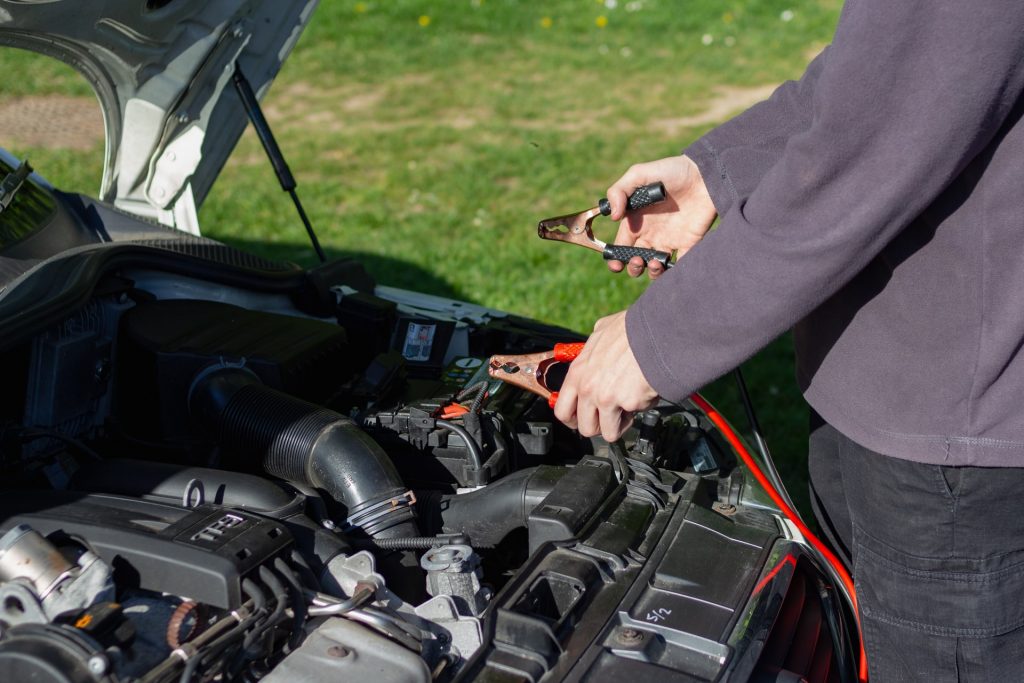We’re all likely to experience having a car that won’t start at some point. Follow this simple guide to tell if it’s a dead battery causing the problem and then how to get it going. You’ll soon be on the road again!
How to tell if your battery is dead
Some indicators of a dead battery, when taken alone, could be symptomatic of several problems. These three signs combined, however, are a dead cert that you’ll need to jump start your car — and think about getting a new battery.
- Your engine cranks, but it won’t fire up, or you hear a clicking sound when you turn the ignition key.
- No electronics work inside the car. Your radio, lights, and electric windows are all dead. Like the engine, these are all powered by the car battery.
- There’s an illuminated battery symbol on your dashboard.
You’re likely to experience warning signs that your battery is in trouble before it gets to this point. These include:
- The car cranking more slowly and taking longer to start
- The car playing up — one day it starts fine and the next it doesn’t
- Regularly having trouble getting the car going in cold weather
What you’ll need to jump start a car
You don’t need much: just a pair of jump cables — usually costing between $20 and $35 — your car with a flat battery, and a vehicle with a fully-charged battery the same voltage as yours. Avoid drafting in an electric or hybrid car as these can cause damage.
Before you get started, check that the dead battery isn’t leaking or damaged and that the jump cables are in good condition and don’t get hot.
Think about what you’re wearing. Remove anything that could get caught in the engine, such as a scarf or tie, and take off metal accessories such as rings or watches. These could cause a spark if they touch the battery.
And it goes without saying, but don’t smoke or use a naked flame near either battery.
Jump start a car with cables
To jump start a car with cables, follow these steps:
- Park both cars so the cables can easily reach between both engines. Ensure both ignitions are off and handbrakes are on.
- Connect the red jump cable to the positive (+) terminal on both car batteries, starting with the working battery.
- Connect the black jump cable to the negative (-) terminal on the working battery to an earthing point on the car with the flat battery. Some have a dedicated point, but if there isn’t one, you can attach it to any unpainted metal on the engine block or chassis. Keep it well away from the battery and fuel pipes.
- Wait a few minutes, then start the car with the working battery. Let it run for a couple of minutes before turning on the car engine with the flat battery.
- Let both cars run for about 10 minutes.
- Turn off both cars and disconnect the cables in the reverse order to how they were connected. This is very important.
- Start the car engine that had the dead battery. If it doesn’t start, there’s likely to be a more serious problem and you’ll need a professional.
How to jump start a car without cables
From a jump start to a bump start — this method, which only works for manual cars, may need a willing volunteer who isn’t afraid of a little exercise!
- Get in the car, turn off all electronics, and put the car into second or third gear with your foot firmly on the clutch.
- Turn on the ignition.
- Get somebody to push you. Or, if you’re on a hill, take your foot off the brake. When the car is moving at a good walking pace, release the clutch and the car should start.
- Let the car run so it can recharge.
FAQ
Will jump starting my car damage the electronics?
No, it won’t if it’s done properly. 12v batteries aren’t powerful enough to cause significant damage, and they often have anti-surge protection. But you can do damage if you don’t disconnect the cables in the order you attached them or if you remove them while the cars’ engines are still running.
Can a car battery be too dead to jump start?
No. All batteries can be jump started. A dead battery is just one that has no charge. Older batteries are less efficient at holding their charge, and, frustratingly, they’ll have you jump starting your car more often.
How often should you change a car battery?
Car batteries are designed to last between three and five years, but it’s not an exact science. Their lifespan depends on a range of factors. The battery is put under more pressure if:
- Your car’s a local run-around making lots of short journeys.
- You’ve got a stop/start revving driving style.
- You love your in-car gadgets.
- You use your car in extreme hot and cold conditions.
- You drive it on poor-quality roads.
A new battery should be on your ‘to do’ list if your car is taking longer to start or it’s unreliable — starting easily on some days and not on others.

